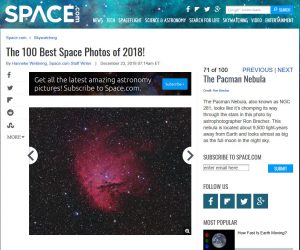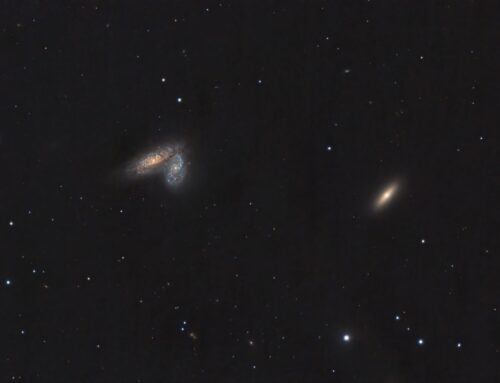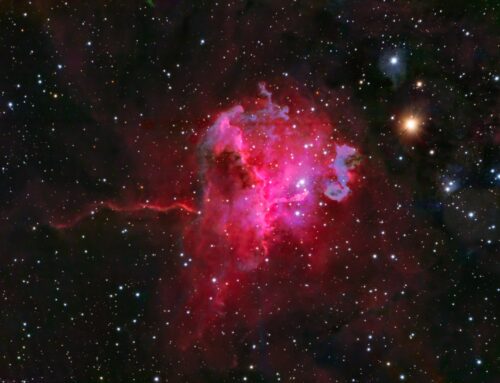NGC 281 – The Pacman Nebula
 Click image for full size version
Click image for full size version
November 20, 2018
 NGC281 is known as the Pacman Nebula. This nickname comes from its appearance, resembling an early video game character. The designation NGC 281 refers to the nebula; the star cluster in the centre is IC 1590. These cluster stars were born out of this hydrogen gas, and now cause it to glow. The black, dense globules are called Bok globules, from which the bright stars are born. The Pacman is about 9,500 light years away, and covers a little more sky than the full Moon. I have imaged this object previously (most recently in 2015), but the current version shows significantly more detail including lots of curdling in the centre of the nebula and a ton of structure around the dark gash near the bottom of the nebula. For you Ha lovers, an Ha only version from 2015 is also available.
NGC281 is known as the Pacman Nebula. This nickname comes from its appearance, resembling an early video game character. The designation NGC 281 refers to the nebula; the star cluster in the centre is IC 1590. These cluster stars were born out of this hydrogen gas, and now cause it to glow. The black, dense globules are called Bok globules, from which the bright stars are born. The Pacman is about 9,500 light years away, and covers a little more sky than the full Moon. I have imaged this object previously (most recently in 2015), but the current version shows significantly more detail including lots of curdling in the centre of the nebula and a ton of structure around the dark gash near the bottom of the nebula. For you Ha lovers, an Ha only version from 2015 is also available.
Tekkies:
Sky-Watcher Esprit 150 f/7 refractor, QHY 16200A camera, Optolong Ha, R, G and B filters, Paramount MX. Acquisition with TheSkyX unguided. Focused with FocusMax 4. Automation with CCDCommander. All pre-processing and processing in PixInsight. Acquired from my SkyShed in Guelph. No Moon for RGB, moderate moonlight for Ha. Average to excellent transparency and fair to average seeing. Data acquired October 29 – November 4, 2018. Image scale is about 1.15 arcsec per pixel for this camera/telescope combination.
16x5m R, 15x5m G, 15x5m B, and 9x10m Ha (Total = 5hr20m).
Data Reduction and Cleanup
The BatchPreProcessing script was used to perform calibration, cosmetic correction and registration of all frames. ImageIntegration was used to make the Ha, R, G and B masters. DynamicCrop was used to crop all the masters identically. DynamicBackgroundExtraction was applied to each master.
RGB
Creation and cleanup: The R, G and B were combined to make an RGB image which was processed with PhotometricColorCalibration.
Linear Noise Reduction: MultiscaleLinearTransform was used to reduce noise in the RGB image. Layer settings for threshold and strength: Layer 1: 3.0 0.8 Layer 2: 2.5, 0.7 Layer 3: 2., 0.6 Layer 4: 1.0, 0.2 Layer 5: 0.5, 0.1.
Stretching: HistogramTransformation was applied to make a pleasing, bright image. Curve was applied to boost contrast and saturation.
Luminance
Creation and cleanup of SynthL: The R, G and B masters were combined using ImageIntegration (average, additive with scaling, noise evaluation, iterative K-sigma / biweight midvariance, no pixel rejection).
Deconvolution: A star mask was made to use as a Local Deringing Support image. A copy of the image was stretched to use as a range mask. Deconvolution was applied (50 iterations, regularized Richardson-Lucy, external PSF made using the PSFImage script).
Linear Noise Reduction: MultiscaleLinearTransform was used to reduce noise in the background areas, using an internal mask to protect bright structures. Layer settings for threshold and strength: Layer 1: 3.0 0.9 Layer 2: 2.0, 0.75 Layer 3: 1.0, 0.6 Layer 4: 0.5, 0.2.
Stretching: HistogramTransformation was applied to make a pleasing, bright image.
H-alpha
Deconvolution: A star mask was made to use as a Local Deringing Support image. A copy of the image was stretched to use as a range mask. Deconvolution was applied (80 iterations, regularized Richardson-Lucy, external PSF made using the PSFImage script).
Linear Noise Reduction: MultiscaleLinearTransform was used to reduce noise in the background areas of the Ha image. Layer settings for threshold and strength: Layer 1: 3.0 0.9 Layer 2: 2.0, 0.75 Layer 3: 1.0, 0.6 Layer 4: 0.5, 0.2.
Stretching: HistogramTransformation was applied to the Ha to make a pleasing, bright image.
Contrast Enhancement: HDRMultiscaleTransform was applied to the Ha twice, at scales of 6 and 4. A mask was used to select bright nebula and protect stars, faint nebula and background sky.
Combining SynthL, RGB and Ha
SynthLRGB: The SynthL was applied to the RGB image using LRGBCombine.
SynthLHaRGB: PixelMath was used to add Ha to the RGB, using the following expressions for the R, G and B channels:
R: max($T[0], 1.1*Ha)
G: $T[1]
B: iif($T[0]<Ha, $T[2] + 0.07*Ha, $T[2])
Additional Processing
Nonlinear Noise Reduction: TGVDenoise was used in L*a*b* mode to reduce noise in the background and dim parts of the nebula.
Sharpening: MultiscaleLinearTransform was used to sharpen Layers 2 and 3 (strengths of 0.2 and 0.12 respectively. A mask was used to protect dim nebulosity, background and stars.
Contrast Enhancement: LocalHistogramEqualization was applied with a scale of 50 (max contrast 1.5, strength 0.3, 1 iteration), followed by a scale of 150 (max contrast 1.5, strength 0.23, 1 iteration).
Final Steps: Star sizes were reduced using MorphologicalTransformation’s Morphological Selection tool with a blurred star mask that selected large and medium sized stars (selection 0.14, strength 0.2, 3 iterations). Background, nebula and star brightness, contrast and saturation were adjusted in several iterations using Curves with masks as required. The DarkStructureEnhance script was applied with 8 layers and a strength of 0.20.






Superb image and love the tech details almost as much Ron, cheers!
Awesome image Ron and great detail. I see you are using new gear too.
Clear skies to you!